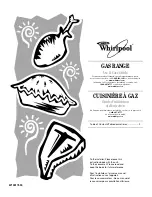
IMPORTANT SAFETY
INSTRUCTIONS
Do not use water on grease
fires. Never pick up a flaming
pan. Turn off burner, then
smother flaming pan by covering
pan completely with a well-fitting
lid, a cookie sheet or a flat tray.
Flaming grease outside a pan can
be put out by covering with
baking soda or, if available, a
multi-purpose dry chemical
or foam-type fire extinguisher.
●
Do not store flammable
materials in an oven or near
the cooktop.
●
Do not store or use
combustible materials, gasoline
or other flammable vapors and
liquids in the vicinity of this or
any other appliance.
Do not let cooking grease
or other flammable materials
accumulate in or near the range.
When cooking pork, follow
the directions exactly and always
cook the meat to an internal
temperature of at least
This assures that, in the remote
possibility that trichina may be
present in the meat, it will be
killed and meat will be safe to eat.
Surface Cooking
●
Always use the LITE position
(for Electric Ignition models)
and HI (for Standing Pilot
model) when igniting top
burners and make sure the
burners have ignited.
●
Never leave surface burners
unattended at high flame settings.
smoking and greasy
spillovers that may catch on fire.
●
Adjust top burner flame size
so it does not extend beyond the
edge of the cookware.
Excessive flame is hazardous.
.
dry potholders--moist
or damp potholders on hot surfaces
may result in burns from steam.
4
Do not potholders come near
open flames when lifting cookware.
Do not use a towel or other bulky
cloth in place of a pot holder.
●
minimize the possibility
of burns, ignition of flammable
materials and spillage, turn
cookware handles toward the side
or back of the range without letting
them extend over adjacent burners.
.
turn surface burner to
OFF before removing cookware.
. Carefully watch foods
being
fried at a high flame setting.
. Never
the
(air
openings) of the range. They
provide the air inlet and outlet
that are necessary for the range
to operate properly with correct
combustion. Air openings are
located in the following places:
–Oven vent at the rear of the
cooktop.
—Air intake under the broiler
drawer.
—Air vent at the top of the oven
door.
●
Do not use a wok on the
cooking surface if the wok has a
round metal ring that is placed
over the burner grate to support
the wok. This ring acts as a heat
trap which may damage the burner
grate and burner head. Also, it
may cause the burner to work
improperly. This may cause a
carbon monoxide level above that
allowed by current standards,
resulting in a health hazard.
.
for frying should be as
dry as possible. Frost on frozen
foods or moisture on fresh foods
can cause hot fat to bubble up
and over sides of pan.
Use least possible amount of
fat for effective shallow or
fat frying. Filling the pan too full
of fat can cause spillovers when
food is added.
●
If a combination of
or
fats will be used in frying, stir
together before heating or as fats
melt slowly.
.
heat fat slowly and
watch as it heats.
.
thermometer
whenever possible to prevent
overheating fat beyond the
smoking point.
●
pan size. Avoid
pans that are unstable or easily
tipped. Select cookware with flat
bottoms large enough to cover
burner grates. To avoid spillovers,
make
cookware is large enough
to contain food properly. This
will both save cleaning time and
prevent hazardous accumulations
of food, since heavy spattering or
spillovers
on the range can
ignite. Use pans with handles that
can be easily grasped and will
remain cool.
.
using glass
make sure it is designed for
of-range cooking.
●
Keep all plastics away from
top burners.
Vent appearance varies.
Do not leave plastic items on
the cooktop—they may melt if
left too close to the vent.
Do not leave any items on the
cooktop. The hot air from the vent
may ignite flammable items and
will increase pressure in closed
containers, which may cause them
to burst.
●
To avoid the possibility of a
burn, always be certain that the
controls for all burners are at
the OFF position and grates
are cool before attempting to
remove a grate.





































